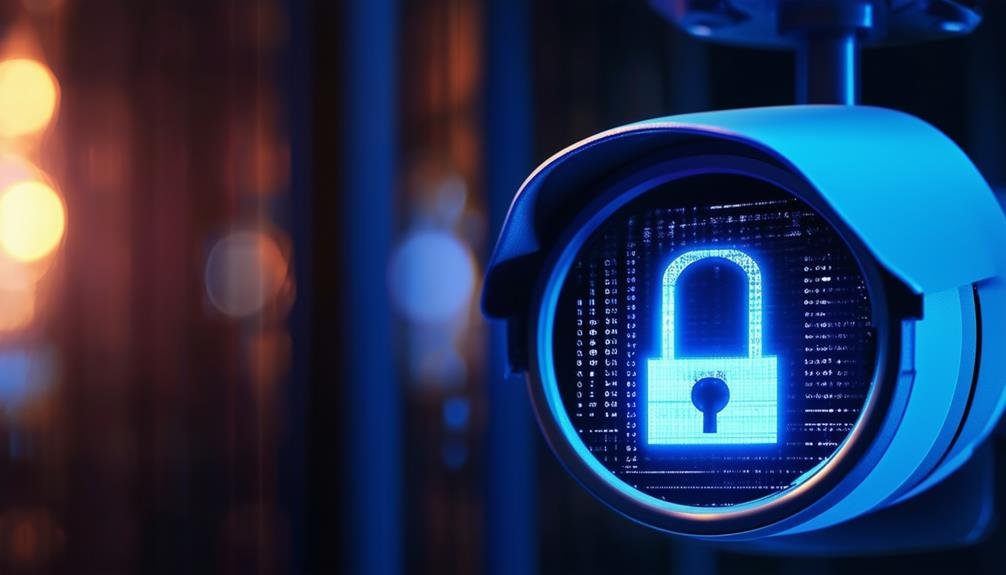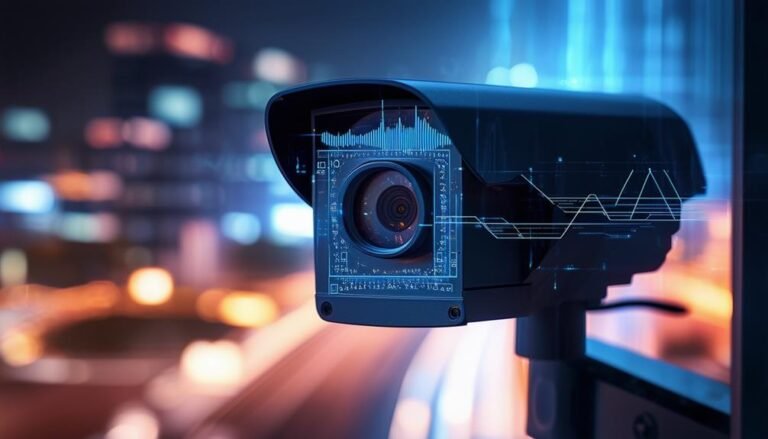Dahua devices usually come with easy default passwords like "admin," "123456," and "888888." If you don't change these passwords, you risk unauthorized access to your surveillance system, making it vulnerable to hackers. These simple passwords can lead to data breaches and even identity theft, so it's essential to update them right away for your privacy and security. A strong password should mix upper and lower case letters, numbers, and symbols. Protect your device further with two-factor authentication. There's more to learn about securing your Dahua devices effectively if you're interested in keeping your system safe.
Overview of Dahua Devices
Dahua devices, known for their advanced surveillance technology, play an essential role in security systems worldwide. These devices encompass a range of products designed to enhance safety and monitor activities in various environments, from residential homes to large commercial enterprises. When you decide to integrate a Dahua device into your security setup, you're investing in advanced features such as high-definition video, night vision, and intelligent analytics that help you keep a vigilant eye on your surroundings.
You'll find numerous options, including IP cameras, digital video recorders (DVRs), and network video recorders (NVRs). Each type of device offers unique capabilities tailored to meet your specific security needs. For instance, IP cameras provide superior image quality and flexibility in installation, while DVRs and NVRs allow you to store and manage your footage efficiently.
With Dahua's cutting-edge technology, you're empowered to take control of your security. The devices often come equipped with remote access features, enabling you to monitor your property from anywhere, using just your smartphone or computer. This level of connectivity means you can respond to potential threats in real-time, promoting a greater sense of freedom and peace of mind.
In today's world, where safety is a priority, having a reliable security system is crucial. Dahua devices stand out for their robustness and versatility, making them a popular choice among those who value their security and independence. Embracing this technology can greatly enhance your ability to safeguard your freedom and property.
Importance of Changing Passwords
Changing your passwords is essential to protecting your Dahua devices from potential security vulnerabilities. If you don't update your default passwords, you risk unauthorized access to your system. By following best practices for passwords, you can greatly enhance your security and keep your data safe.
Security Vulnerabilities Exploitation
Failing to change default passwords can open the door to significant security vulnerabilities. When you leave these passwords unchanged, you're fundamentally inviting intruders to exploit your devices or systems. Default passwords are often publicly known or easy to guess, making them a prime target for hackers. If you value your freedom and security, it's crucial to take this seriously.
Imagine a scenario where someone gains unauthorized access to your surveillance system or network. They could manipulate your devices, steal sensitive information, or even use your system for nefarious purposes. By not changing default passwords, you're giving up control over your own security.
You might think, "It'll never happen to me," but the reality is that cyber threats are prevalent and can affect anyone. Taking the simple step of changing your default passwords to something unique and complex is a powerful move toward safeguarding your independence.
Don't let complacency compromise your security. Embrace the responsibility of protecting your digital life by updating those passwords today. It's a small effort that can lead to significant peace of mind and freedom from the fear of exploitation.
Risk of Unauthorized Access
Leaving default passwords unchanged greatly increases the risk of unauthorized access to your devices and systems. When you don't take the time to change your passwords, you're fundamentally handing over the keys to your digital freedom. Hackers know that many people forget this vital step, making your systems a prime target.
Here's a quick look at the potential risks:
| Risk Type | Description | Consequence |
|---|---|---|
| Data Breach | Unauthorized access to sensitive information | Identity theft, financial loss |
| Remote Control | Hackers can take control of your devices | Privacy invasion, system manipulation |
| Malware Installation | Attackers can install harmful software | Data corruption, system failure |
| Reputation Damage | Breaches can harm your brand or image | Loss of trust, business decline |
Best Practices for Passwords
Understanding the importance of regularly updating your passwords is crucial for maintaining security. You want to guarantee that your digital life remains private and protected from unwanted intrusions. By changing your passwords regularly, you're not only safeguarding your accounts from potential breaches but also reinforcing your stance on personal freedom and privacy.
It's essential to use strong, unique passwords for each of your accounts. Avoid common phrases or easily guessable information like birthdays. Instead, consider using a combination of uppercase and lowercase letters, numbers, and special characters. This complexity makes it much harder for anyone to crack your password.
Additionally, consider using a password manager. These tools help you generate and store strong passwords securely, so you don't have to remember every single one. You can also enable two-factor authentication wherever possible. It adds an extra layer of security, guaranteeing that even if someone gets your password, they can't access your account without that second verification step.
Common Dahua Default Passwords
When setting up your Dahua devices, it's crucial to be aware of the common default passwords they come with, as these can pose significant security risks if left unchanged. Most Dahua devices come with a factory-set password, which is often simple and easy to guess. The most frequently used default password is "admin," which many users stick with out of convenience. Another common one you might encounter is "123456," a password so basic that it's almost an invitation for unauthorized access.
You could also find variations like "888888" or "12345678," which are often used for specific models. Some older devices might come with more unique identifiers, such as "Dahua" or "dahua123." Remember, these passwords are public knowledge; hackers often target devices using default settings, knowing many users don't bother to change them.
If you want to protect your privacy and maintain your freedom, it's crucial to update these passwords immediately after installation. It's not just about setting them; it's about creating a strong, unique password that only you know. Consider using a mix of uppercase and lowercase letters, numbers, and special characters to enhance security.
How to Access Dahua Devices
To access your Dahua devices, you'll first need to connect them to your network, as this guarantees they can be reached via your computer or mobile device. Start by plugging in your device and ensuring it's powered on. Connect it to your router using an Ethernet cable or connect it wirelessly if your model supports it. Once that's done, you should see its indicator lights signaling a successful connection.
Next, you'll want to determine the device's IP address. This can usually be found in your router settings or through a Dahua tool designed to discover devices on your network. If you're unsure how to locate this, consult your router's manual or the Dahua documentation for guidance.
With the IP address in hand, open a web browser on your computer and enter the IP address into the address bar. This should direct you to the login page of your Dahua device. Here's where you'll use the default username and password, which you should have noted earlier. Don't worry if you've forgotten; just check the previous section for common default passwords.
Once logged in, you'll have the freedom to explore the settings and features of your Dahua device. You can configure your preferences, set up alerts, or manage your camera views. Remember, taking control of your security system is all about ensuring you have access to what you need, when you need it. Enjoy the flexibility of your Dahua device!
Steps to Change Default Password
To change the default password on your Dahua device, you'll first need to access the device settings. Once you're in, you can easily set a new password to enhance your security. Let's walk through the simple steps to get this done.
Access Device Settings
Accessing your device settings is essential for changing the default password and enhancing your security. To get started, connect your device to a secure network and enter its IP address into your web browser. This should take you to the login page. If you haven't changed your credentials yet, use the default username and password, often found in the user manual or on the manufacturer's website.
Once you've logged in, navigate to the settings menu. Look for an option labeled "User Management" or "Account Settings." This is where you can manage your passwords and user accounts. Take a moment to familiarize yourself with the layout and available options; knowing your way around helps you make informed decisions.
Set New Password
Once you're in the settings menu, it's time to change the default password to something more secure. This step is essential for maintaining the freedom of your device and guaranteeing your privacy. Here's how to do it:
- Locate the Password Section: Find the user settings or account management area within the menu.
- Enter the Current Password: Input the default password to access the change options.
- Create a New Password: Choose a strong password—ideally, a mix of letters, numbers, and special characters. Aim for at least 8 characters to enhance security.
- Confirm the New Password: Re-enter your new password to verify there are no typos.
Once you've done that, save your changes and enjoy the peace of mind that comes with knowing your device is more secure. Changing the default password is a simple yet essential step in taking control of your security. Embrace your freedom by safeguarding your personal information—because you deserve to feel safe in your digital world!
Tips for Strong Password Creation
In today's digital age, creating a strong password is crucial for protecting your sensitive information. You want the freedom to navigate online without worrying about unauthorized access. So, let's explore some effective tips for crafting a password that keeps your data safe.
First, aim for a password that's at least 12 characters long. The longer, the better. Mix upper and lower case letters, numbers, and special characters to create a complex combination that's hard to guess. Avoid using easily obtainable information, like your name, birthdate, or common words—these can be a hacker's best friend.
Consider using a passphrase instead of a single word. A memorable sentence or a series of random words can make a strong password that's both secure and easy for you to remember. Just make sure it's unique to you and not something you'd readily share.
Don't forget to change your passwords regularly. If you suspect a breach or if you've shared your password, it's time for a reset. And remember, using different passwords for different accounts is essential. That way, if one account is compromised, the others remain secure.
Finally, consider using a password manager. These tools can help you generate and store complex passwords securely, giving you the freedom to create unique passwords without having to memorize every single one.
With these tips, you can confidently protect your digital life and maintain the freedom you cherish.
Security Risks of Default Passwords
Default passwords pose significant security risks that can leave your devices vulnerable to unauthorized access. When you set up a new device, you might think it's safe to stick with the factory settings. However, this can be a recipe for disaster. Cybercriminals often exploit these defaults, gaining entry into your system with ease. Here are some key risks associated with using default passwords:
- Easy Exploitation: Hackers know the default passwords for most devices. They can quickly run scripts to test these common passwords, making it incredibly easy for them to break in.
- Data Breaches: If someone gains access to your device, they can steal sensitive information, such as personal data, financial records, or even confidential business information.
- Unauthorized Control: A hacker can manipulate your device, turning it into a surveillance tool or using it to launch attacks on other systems without your knowledge.
- Legal and Financial Consequences: If your device is compromised and used for illegal activities, you could face severe repercussions, including fines and legal action.
Updating Firmware for Security
Keeping your devices secure goes beyond just changing default passwords; it also involves regularly updating the firmware. Firmware updates aren't just technical jargon; they're your frontline defense against vulnerabilities. Manufacturers like Dahua release these updates to patch security holes, enhance functionality, and improve overall performance. When you skip these updates, you're leaving your device exposed to potential threats.
You might wonder why it's crucial to stay on top of firmware updates. Think of it as maintaining a well-oiled machine. Just as you'd change the oil in your car to keep it running smoothly, updating firmware guarantees your device operates efficiently and securely. By not keeping up with these updates, you're fundamentally giving intruders an open invitation to access your data and disrupt your security system.
Best Practices for Device Security
Regular firmware updates are just one part of a thorough approach to device security. You want your devices to operate smoothly and safely, so adopting best practices is crucial. Here's a concise list to help you enhance your security and protect your freedom:
- Change Default Passwords: Always replace default passwords with strong, unique ones. This simple step can make a huge difference in preventing unauthorized access.
- Enable Two-Factor Authentication (2FA): If your device supports it, turn on 2FA. It adds an extra layer of protection by requiring a second form of verification, making it harder for intruders to gain access.
- Limit Network Exposure: Keep your devices off public networks whenever possible. Use a VPN to secure your connection and avoid exposing your devices to potential threats.
- Regularly Review Device Permissions: Periodically check which users have access to your devices and their settings. Remove any users who don't need access, and verify that permissions are set appropriately.
Frequently Asked Questions
Can I Recover a Lost Dahua Password?
If you've lost your Dahua password, don't worry, you can recover it. Start by checking the device's manual for password recovery options or utilize the built-in reset features. Sometimes, contacting Dahua's customer support can help you regain access. Make sure to have your device information ready. Remember, keeping a secure record of your passwords can prevent this hassle in the future, allowing you to maintain your freedom and access effortlessly.
Are Default Passwords the Same for All Dahua Models?
When it comes to default passwords, they aren't all one-size-fits-all—like trying to fit a whale into a tiny car! Each Dahua model often has its own unique default password, though some may share similarities. It's essential to check the specific documentation for your device. If you're aiming for freedom in accessing your system, always change that default password to something secure and personal to avoid unwanted intrusions.
How Often Should I Change My Dahua Password?
You should change your Dahua password regularly to maintain security. It's a good idea to do this at least every three to six months. If you suspect any unauthorized access or if you've shared your password, change it immediately. By keeping your password fresh, you're taking control of your security and ensuring your privacy. Remember, a strong, unique password is key to protecting your devices and personal information from potential threats.
What if the Default Password Doesn't Work?
If the default password doesn't work, don't panic. It might be because the device was set up with a custom password or it's been changed previously. You can try resetting the device to factory settings, which usually restores the default credentials. Just remember that this will erase any existing configurations. Once you regain access, it's a good idea to set a strong, unique password to maintain your security and freedom.
Do Dahua Devices Support Two-Factor Authentication?
Yes, Dahua devices do support two-factor authentication, which adds an extra layer of security to your surveillance system. By enabling this feature, you'll guarantee that even if someone gets hold of your password, they can't access your device without the second factor. It's a smart way to protect your privacy and enhance your freedom. Just remember to keep your authentication method secure, so you can enjoy peace of mind while using your Dahua products.



